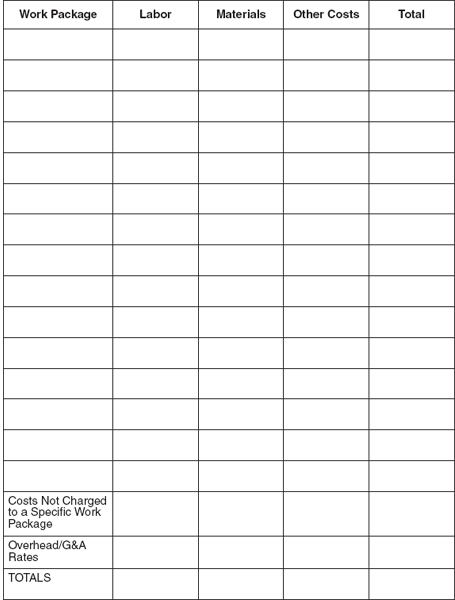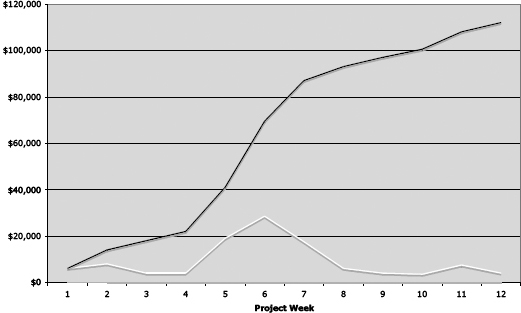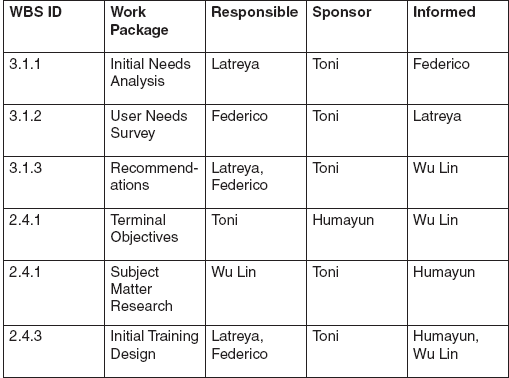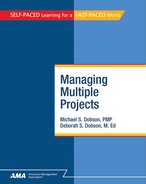Planning for Cost, Quality, Communications, Procurement, and Human Resources

Learning Objectives
By the end of this chapter, you will be able to:
• Prepare a cost estimate for a project at rough order of magnitude, budgetary, and definitive levels.
• Know how and when to perform a three-point estimate and PERT analysis on projects with high inherent uncertainty.
• Define quality standards on the project through requirements management.
• Build a Resource Assignment Matrix (RAM) for staffing the project.
• Identify procurement and contracting issues that require planning.
• Create a communications plan for your project.
Estimated timing for this chapter:
| Reading | 25 minutes |
| Exercises | 2 hours |
| Review Questions | 10 minutes |
| Total Time | 2 hours 35 minutes |
COMPREHENSIVE PROJECT PLANNING
Traditional project management focuses most heavily on scheduling and risk management because those processes tend to work the same way regardless of the project content. If you’re scheduling workers on a construction project or physicists on a cyclotron, a person is still a person and a week is still a week. Similarly, the risk management process is independent of the risks you discover. No matter what kind of project you have, you need to identify the risks, analyze the risks, determine your responses to the risk, and monitor the actual situation.
In the other important areas of project planning, this kind of commonality is not always present. In this chapter, we’ll discuss planning for cost, quality, communications, procurement, and human resources. As a manager of multiple projects, you will perform this kind of planning for your program as a whole and for the individual projects within that program.
COST PLANNING
The process of cost planning involves preparing cost estimates at different levels of detail, negotiating project budgets, and allocating costs to individual work packages in the project.
Cost Estimating
Depending on your project circumstances, you will sometimes be given a budget within which you must operate, and sometimes you will prepare an estimate and negotiate the budget. Even when the budget is fixed, however, you must normally develop a series of cost estimates to determine if in fact the budget is adequate to accomplish the scope of work within the deadline. If not, you may have to (a) negotiate additional funds, (b) reduce scope or extend time, (c) develop a creative workaround, or (d) fail to meet one or more of the Triple Constraints requirements.
There are a variety of estimating techniques you can use. Some are more accurate than others; some are more time-consuming and difficult than others; some require information that you may or may not possess at the time you prepare the estimate. Exhibit 9-1 details the various levels of estimating.
Analogous Estimating
Analogous estimating is estimating by analogy — using actual information from a previous, similar project as a basis for your estimate. If, for example, you want to determine the cost of building a new office building, you start with the actual cost of a similar office building built recently and in the same area. The major advantage of this technique is that it is quick and easy; its disadvantage is that it’s not very accurate.
Although you normally have full data about the analogous project, you often do not have full information about all the differences between the previous project and the proposed one. Will the new building be bigger or smaller? Are there special areas or other features? Has much changed recently in the real estate environment?
This technique is best suited for creating rough order of magnitude estimates, where you or the customers need only a general idea of costs. It is often used as a way for customers to determine whether to proceed with a project in the first place. It is dangerous to rely too much on the precision of an analogous estimate.
xhibit 9-1
Levels of Cost Estimate Accuracy

Expert Judgment
Estimating by expert judgment means asking an expert what he or she thinks a project will cost. Some people simply know more about a particular project area than you do. Their judgment and experience can provide great insight into the cost/risk profile of a project. The two major factors to consider are (a) whether the expert is actually the right expert for this particular estimate, and (b) whether the expert has a stake in a particular project outcome.
Experts themselves may use a variety of estimating techniques to help them develop their estimate. Sometimes multiple experts are consulted to get a range of ideas. To avoid the experts being influenced by one another, it’s often desirable to use the Delphi Method, in which each expert submits an independent written estimate, and the estimates are not seen by the others until all are complete.
Parametric Estimating
Parametric estimating involves building a model to calculate likely costs of a particular project. For example, another way to determine the likely cost of an office building is to express it as a cost-per-square-foot number. The average per square foot cost for commercial office space construction can range from $100 to $200 per square foot, depending on materials and furnishings. Therefore, if you want to build 10,000 square feet of office space, a parametric estimate for the project is between $1 and $2 million.
Parametric estimates rely on models: statistical relationships between historical data and other variables. Models can be simple (cost per square foot) or enormously complex. If you buy life insurance, for example, the agent enters selected information about you into an extensive statistical database. The proposed premium for the level of coverage you seek is the result of a parametric estimate.
xhibit 9-2
PERT Analysis Formula for Three-Point Estimates

Three-Point Estimates (PERT)
The famous Program Evaluation and Review Technique (PERT) provides a way to increase estimating accuracy when uncertainty is high. It does so by having you create three different estimates to establish a potential range for cost, duration, or anything else you’re estimating.
CM = Most likely cost
CO = Optimistic/best-case scenario cost
CP = Pessimistic/worst-case scenario cost
The estimated cost is developed from the three-point range using the PERT analysis formula shown in Exhibit 9-2.
If you have a best-case estimate of $100,000, a most likely estimate of $200,000, and a worst-case estimate of $600,000, the three-point estimate is $100,000 + (4 × $200,000) + $600,000 / 6, or $250,000.
Bottom-Up Estimating
In a bottom-up estimate, you develop individual estimates for each work package and add up the numbers to create a total estimate for the entire project. A bottom-up estimate is usually the most accurate type of estimate; however, in order to develop it, you need to have a full Work Breakdown Structure (WBS) showing all the work in the project.
To develop the bottom-up estimate for the project, use a cost estimating worksheet for each work package, and develop a detailed estimate for each level of the WBS. Then add the estimates for each level of the WBS (a “roll-up”) until you reach Level 1 of the WBS.
Bottom-up estimates are the most time-consuming but also the most accurate. The greatest dangers in a bottom-up estimate are: (1) people lower in the WBS hierarchy may add a layer of reserve (“padding”) at each level, resulting in an inflated estimate, or (2) project-level overhead functions may be forgotten, giving too small an estimate for the job.
Exhibit 9-3 provides an example of a bottom-up estimate for the ABC Database project, using the WBS from Exhibit 4-5. Note that in practical terms, you’d want to add some allowance for risk and estimating error, so a bottom-up estimate of $423,000 might turn into a project estimate of $450,000 or even $500,000, depending on your assessment of the level of risk.
xhibit 9-3
Bottom-Up Estimate

Exercise 9-1
Preparing a Bottom-Up Cost Estimate
Using the form provided, estimate the costs for the project WBS you developed in Exercise 4-2.

Cost budgeting is the process of allocating money and other resources to individual work packages and to project overhead costs. In cost budgeting, you create two products: a budget for the project, and a spend plan, usually displayed as an “S” curve.
A project budget is normally organized the way your company prefers it. You may choose to express the budget in terms of the cost of performing each individual work package, similar to the presentation in Exhibit 9-3, or you may need to classify overall project costs by category, such as total labor, total materials, or total overhead. If you will be using the Earned Value Method or otherwise need to keep track of spending over time (such as for cash flow management purposes), you may also display your budget as an “S” curve, as shown in Exhibit 9-4.
QUALITY PLANNING
The Triple Constraints of time, cost, and performance define the outer edges of the project envelope, but quality makes the project better than the minimum in some way that is meaningful to the customer and appropriate in terms of additional cost or time.

xhibit 9-4
Spend Plan
The white line represents the anticipated outlays for each week of the project. The black line represents the cumulative dollars spent. It is known as the baseline or cost baseline.

The discipline of quality management is well understood, but projects have their own unique issues. For example, the idea of “continuous improvement” can be applied to projects, but if you try achieve continuous improvement within a specific project, you’ll never finish.
Quality covers a number of areas in a project: the quality of the final product or service, the quality of the process with which it was done, and the degree to which customer expectations and needs are met or not met. While quality includes “quality control,” or inspection, inspection itself is not quality. Inspection doesn’t improve the product or service, or the process with which it’s delivered; it merely keeps defects out of the hands of the customer. Costs and time associated with those defects, however, often remains your responsibility.
The first step in designing quality into a project is defining what constitutes quality in the first place. Quality may be defined as “exceeding customer expectations,” in which case you must start first by defining what those expectations are, and then defining what constitutes meaningful improvement. Some quality programs focus on the “-ilities”—identifying factors such as manufacturability, repeatability, safety, or security, that often (but not always) end in “- ility.” Some of these are more important than others for a given project.
The operational mechanism by which quality is built into a project is through requirements management. To deliver what the customer wants, you have to define what the customer wants in enough detail so that the project manager and project team are able to deliver it. And don’t forget the importance of “good enough.” All projects require tradeoffs among the Triple Constraints. Given unlimited time and unlimited money, you might be able to provide perfection, but that option isn’t usually on the table where project managers are concerned.

Think About It …
What are the key quality issues for your projects, and how will you make sure they are achieved?
HUMAN RESOURCES PLANNING
A key question for project planners is to determine the human resource requirements for your project, and how you will obtain and use them. Analysis of the WBS and schedule will determine the number of people required to do the job; analysis of the subject matter will determine the level and type of skills required.
The standard tool for human resource planning in project management is known as a Resource Assignment Matrix (RAM). A RAM shows all the people who must perform on any given work package. For each WBS item, list those who perform each of the following three roles:
• Responsible: Those who do the actual work, complete the task or objective, or make the necessary decision.
• Sponsor: The owner of the work, the person who signs off or approves the successful conclusion of the task. The sponsor is normally accountable for the results.
• Informed: Those who must be kept in the loop, but who have no direct responsibility for or ownership of the work package
Exhibit 9-5 shows a sample RAM, based on the work packages from the WBS shown in Exhibit 4-6. Note that people perform different roles on different work packages, as well as on different branches of the WBS.

xhibit 9-5
Sample Resource Assignment Matrix

Exercise 9-2
Creating a Resource Assignment Matrix
Using the project described in Exercise 9-1, complete a Resource Assignment Matrix showing the people needed to accomplish the work packages from the WBS.

Human resource planning on a project isn’t merely about determining staffing needs, but also about team-building, motivation, leadership, and the range of tools needed to get anyone to perform work. While a complete discussion is far outside the scope of this self-study course, it’s vital for the manager of single or multiple projects to think long and hard about this common challenge area.
Think About It …
What human resources, supervisory, or influence management issues are likely to arise on your project? How can you best manage them?
Team Building Issues ___________________________________________________________
Motivation Issues ______________________________________________________________
Leadership Issues______________________________________________________________
Other Human Resources Issues___________________________________________________
PROCUREMENT PLANNING
When some or all of your projects involve procurement or contracting, an entirely new set of questions arises. What parts of the project will you perform in-house and what parts will be contracted to others? If procurement and contracting will constitute a significant portion of your project activities, it’s vital to make a separate part of your plan for how you will handle these functions.
A procurement plan is normally presented as a document that outlines the steps, the processes, and the rules that govern project procurement. It must conform to the organization’s policies and regulations, and to applicable laws. The following template defines the elements that a procurement plan normally contains. The amount of detail varies both by the size of the anticipated procurement (spending a few hundred dollars can be done informally; spending millions needs a plan), by the sector (government procurement regulations restrict what you are allowed to do in order to ensure fairness among different bidders), and by the nature of the products or services being procured (offthe-shelf versus highly customized, for example).
xhibit 9-6
Procurement Plan Elements
1. How will you identify vendors to provide the products or services you need to buy? Will you send a request for proposals or simply buy commercially?
2. If there are multiple vendors, how will you select among them? Will you judge on price, quality, speed, or other factors? Will you weight them numerically or informally?
3. What kind of contract will you use? Will you be buying on a fixed-price basis or will the final price be variable?
4. How will you monitor vendor performance? What will you do if products or services are unsatisfactory or late?
5. What kind of documentation will you keep for procurements?
6. What is the process for paying contractors for their services? Who is authorized to sign that goods and services have been received and that they are satisfactory?
7. What internal processes or controls affect or limit your choices?
Exhibit 9-6 lists common elements in a procurement plan. Note that you can write a standard procurement plan to cover a large number of different projects within the same organization, and make minor adjustments as necessary for individual projects.

Think About It …
What parts of your projects involve procurement or contracting? What internal processes must you follow to make purchases? Who has the authority to sign the necessary contracts? How will you select and monitor contractors? What is the process for final acceptance and payment of invoices? What records must you keep?
The final part of developing a comprehensive project plan is to determine the communications needs. How often will project status be reported, in what form, and to whom? If there will be a project team, should you use a team charter? How will the customer and user be kept informed of project progress? How will risks and other issues be resolved? To improve quality and save time, project management organizations often establish a standard communications protocol to which all new projects automatically conform.
Exhibit 9-7 provides a form to plan communications needs for both single and multiple project environments.

Exercise 9-3
Creating a Communications Plan
Using the project described in Exercise 9-2, prepare a communications plan identifying key stake-holders and your plans for communicating project information with them.


Traditional project management tools focus on scheduling and risk management, but there are other areas that make up a project plan: cost planning, quality planning, human resources planning, procurement planning, communications planning.
Cost planning involves estimating the likely costs associated with a project, negotiating the project budget, and adjusting the project when resources are not available. A cost estimate can be made at a level of rough order of magnitude, budgetary, or definitive, depending on the purpose of the estimate and the amount of information available about the project. Common tools for cost estimating in projects include analogous estimating, expert judgment, parametric estimating, three-point estimating, and bottom-up cost estimating. Cost budgeting involves allocating the available money and resources to work packages. Budgets may be displayed differently depending on the organization. To prepare a cost baseline for the project, make an “S” curve graph showing cumulative expenditures through the project timeline.
Quality planning is the process of making sure that both process and result are efficient, effective, and meet or exceed customer expectations. Human resource planning is the process of determining the staffing needs of the project, acquiring, motivating, scheduling, and leading staff. Procurement planning is the process of planning for contracts and purchases. Finally, communications planning is the process of making sure that information about project activities, issues, and accomplishments travels to the right people in your stakeholder environment.
Review Questions
|
1. If you have a full WBS for all levels of the project, you can use: (a) parametric estimating. (b) analogous estimating. (c) bottom-up estimating. (d) three-point estimating. |
1. (c) |
|
2. If you use the actual cost of a similar project to develop a cost estimate of your current project, you are using: (a) parametric estimating. (b) analogous estimating. (c) PERT analysis. (d) budgetary estimating. |
2. (b) |
|
3. Some quality management strategies focus on the “-ilities,” which are: (a) manufacturability, repeatability, safety, security, and other values. (b) a balanced scorecard approach to time, cost, and performance. (c) a Japanese term meaning quality assurance. (d) the technical process for exceeding customer expectations. |
3. (a) |
|
4. In developing a project communications plan, you should always: (a) implement teleconferencing standards for project meetings. (b) make sure all users are satisfied with the same reporting format. (c) consider the information needs and frequency for each stakeholder. (d) get everyone to come to the weekly meetings. |
4. (c) |
|
5. The standard tool for human resource planning in project management is known as a RAM. RAM stands for: (a) Requirements and Manpower. (b) Resource Assignment Matrix. (c) Random Access Memory. (d) Ready, Able, Manageable. |
5. (b) |


